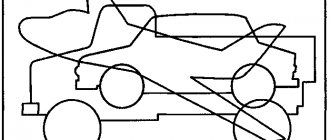Project “Furniture Around Us” for the senior group
Ekaterina Stolyarova
Project “Furniture Around Us” for the senior group
Author of the project : E. V. Stolyarova.
Type of project : informational and creative, group .
Project participants : children of the senior group “Bees”
, teacher, parents.
Project implementation period : short-term (from 07.11. to 10.11.2017)
.
The goal of the project : to expand and systematize children's ideas about pieces of furniture and their meaning .
Project objectives :
— clarify and expand the idea of furniture , form the concept of furniture ;
— introduce the history of the creation of a table and chair, the profession of a carpenter;
- develop cognitive interest and logical thinking;
- activate children's vocabulary: furniture , wardrobe, bed, sideboard, sideboard, sofa, armchair, ottoman, chest of drawers, table, chair, shelf, cabinet, stool, armrest, backrest, seat, leg.
— to cultivate a caring attitude towards things made by human hands.
Relevance
In the modern world there is a variety of furniture . They differ not only in appearance, but also in the materials from which they are made. Older children are tireless “Why”
and we need to help them get acquainted with pieces of
furniture . Parents, as active participants in the project , must consolidate knowledge with the child at home and then the result of the project will be positive .
Expected results:
children's horizons about furniture ;
children's vocabulary has been enriched;
Children can compose a story from pictures and description stories.
Project implementation stages :
Stage 1 - Preparatory
Project development .
Selection and study of methodological literature.
Preparation of fiction, riddles, proverbs, didactic games on the topic, illustrations.
Drawing up a daily calendar plan.
Stage 2 - Main
"Cognitive Development"
Conversations “What is furniture ?”
,
“Who makes
furniture ?” ,
"
Furniture in your home " .
“Formation of a Holistic Picture of the World”
(FCCM)
.
1. Topic: furniture appeared ”
Goal: to consolidate knowledge about furniture , the various materials from which furniture ; teach to fantasize, come up with new qualities for furniture .
2. Topic: “The house we live in”
Goal: to consolidate ideas about the premises in the apartment, pieces of furniture , household appliances, and their purpose.
"Speech development"
1. Topic: “Parcel from Prostokvashino”
(Looking at objects and writing stories)
.
Goal: to teach children to look at objects, compare them, group them , classify them. To train children in the ability to construct sentences grammatically correctly. Develop attention and logical thinking.
2. Topic: Sound culture of speech: working with sounds zh – sh.
Goal: to train children to clearly pronounce words with the sounds zh and w; to develop phonemic hearing: to improve the intonation expressiveness of speech, to practice speech breathing.
"Social and communicative development"
Conversation “Safe behavior in the group and on the site ”
.
D\i "Professions"
,
“Dollhouse”
,
“Let’s furnish the apartment”
,
“Big - small”
,
“One-many”
,
“What is it made of?”
,
“What’s extra”
,
“Count it”
,
“Give me a word”
.
C\r games Furniture Salon "
,
"Family"
.
"Artistic and aesthetic development"
Drawing
1.Topic: “ Furniture for gnomes ”
.
Goal: to develop children’s ability to draw with colored pencils, make a sketch with a simple pencil, and place the drawing across the entire sheet.
2. Drawing by design.
Goal: to develop children’s ability to conceive the content of their drawing and bring the idea to completion. Develop creativity and imaginative ideas.
Modeling
Topic: “ Furniture for a dollhouse”
Goal: to develop the ability to sculpt doll furniture from plasticine .
"Reading fiction"
Stories: Zhitkov B. S. “How I caught little men”
, Nishcheva N.
“
Furniture can be different ” O. V. Dybina
“What happened before.”
.
Fairy tales: "Ole-Lukoje"
(Translation from Danish by A. Hansen, Russian folk tale
“The Three Bears”
,
“Masha and the Mouse”
, etc.
Riddles and poems about furniture .
Construction
Construction of furniture from construction sets , cubes, geometric shapes, sticks.
"Physical development"
P\i “Find furniture ”
,
"Higher than your feet off the ground"
,
Finger games and exercises.
Physical training " Furniture "
.
Working with parents:
Homework for parents “Journey around the house”
-tell the children what kind of
furniture , write a story “
Furniture in my room ” .
"Read to the Children"
: riddles, fiction about
furniture .
Stage 3 - Final
Exhibition of children's creativity.
Consultation for parents.
Notes on cognitive development on the topic Furniture (senior group)
Abstract of educational activities on cognitive development with elements of research activities in the senior group on the topic: “Furniture”
Target:
activating children's knowledge about furniture; the material from which it is made.
Educational objectives:
activate nominative, predicative, attributive vocabulary on the topic “Furniture”. Learn to form and correctly use relative adjectives in speech, practice the formation of the plural form of the nominative case and the genitive case of nouns.
Developmental tasks:
develop the ability to compare, identify characteristics of objects, establish cause-and-effect relationships between objects and materials, generalize and draw conclusions. Develop mental operations of generalization and classification.
Educational tasks:
to develop skills of cooperation, a positive attitude towards participation in joint activities, initiative and independence. Cultivate a caring attitude towards household items
Equipment:
— Cards for the game “Fourth Odd.”
— Illustration “ancient people”.
— For educational and research activities: stones, boards, nails, hammer.
— Scheme: Stone - saw - nail with hammer - plane (all actions are crossed out). Wood - saw - nail with hammer - plane.
— Cut-out pictures (furniture).
— Scheme: one – many – none.
GCD move:
Organizing time.
Hello, golden sun! (Show the sun).
Hello, blue sky!
(Show the sky).
Hello, light breeze!
(Show “breeze”).
Hello, little oak tree!
(Show “oak tree”).
Hello, high chair! (Point to the chair).
Hello, table! (Point to the table).
Hello, guest, you have come to us! (Waving to guests).
Hello, Morning!
(Gesture to the right).
Hello Day!
( Gesture to the left
).
We are not too lazy to say hello!” ( Spread both arms to the sides
).
Main part.
By the time the guests arrived, we had put the family in order, but some items were out of place.
Exercise “4th extra”:
- Look carefully and name the extra object.
- slippers, sneakers, chair, shoes.
- cap, bed, hat, scarf.
- dress, T-shirt, wardrobe, trousers.
- jacket, overalls, coat, chair.
(Put the image of the extra item on the board).
— How can you call all these objects in one word? (Furniture)
Teacher's story, illustration:
— A long time ago, when there were no villages or cities, people lived in caves. To escape the rain and cold, they lit fires and warmed themselves by the fire.
What do you think people used to relax on? (On the grass, on the ground, on the stones).
- Think about whether it was convenient for them or not. Why was it uncomfortable? How did they feel? (Hard, uncomfortable).
The ancient people were uncomfortable, the earth was wet, cold, hard, the stones were sharp.
- If you lie in the cold for a long time, what happens? (You can freeze, catch a cold, get sick).
And then one day, the hunters, returning with their prey, sat down to rest on a fallen tree. Imagine that you are in the forest, sitting on a tree. Comfortable? Better than on earth?
It was then that the man began to think, what should he make furniture from? There were only rocks and trees around the cave.
- Let's examine and compare stones and wood (touch it, put it on your cheek, smell it).
Research activities.
- Touch the stone, tell us about it (hard, cold, heavy, uneven, rough, strong).
—
Touch the wood, tell us about it (
it’s pleasant to the touch, warm, strong, you can plan it and it will become smooth, you can drive a nail into it well, you can drill holes in it).
— Tell me, can a stone be cut? (No)
—Can you hammer a nail into a stone? (No)
—Can the stone be cut? (No)
— Let’s denote all these actions with the following diagram. (Show diagram)
—Can the tree be cut?
—Can you hammer a nail into a tree?
—Can the tree be cut?
— Let’s denote actions with a tree as follows. (Show diagram)
— Look at the diagrams and tell me, what is easier to make furniture from? Why?
Conclusion
: A person chose wood to make furniture because it is pleasant to the touch and can be processed well.
Later, furniture began to be made from other materials.
Exercise “What is furniture made of?” (in a circle)
wooden furniture – what kind? (wooden)
made of metal - which one? (metal)
made of plastic - which one? (plastic)
made of glass - which one? (glass)
We remembered what furniture is made of, and now we’ll build it ourselves.
Finger game "Furniture"
This is a chair - they sit on it ( the left palm in a fist is pressed against the right, fingers extended upward
).
This is a table - people sit at it ( the left hand is in a fist, the right open palm lies on top
)
Here is a bed - they are lying on it ( arms bent at the elbows in front of the chest, lying one on top of the other
)
We put things away in the closet ( imitation of folding things
)
We all go for a walk ( the fingers of both hands walk on the knees
)
In order for furniture to last longer, you need to take care of the furniture.
.
- How should this be done? (Wipe, wash, clean, repair, vacuum, knock out).
Cut pictures
(of four parts). Exercise “Name the parts of an object.”
Collect furniture items.
- What happened? (I got a chair, a wardrobe, an armchair)
- Name the parts of a chair, cabinet, armchair.
Game "One, many, no."
Talk about your subject using a diagram. (One - many - no).
Reflection.
— What do you remember most?
— What furniture would you choose for your apartment? Why?
— What did you especially like?



